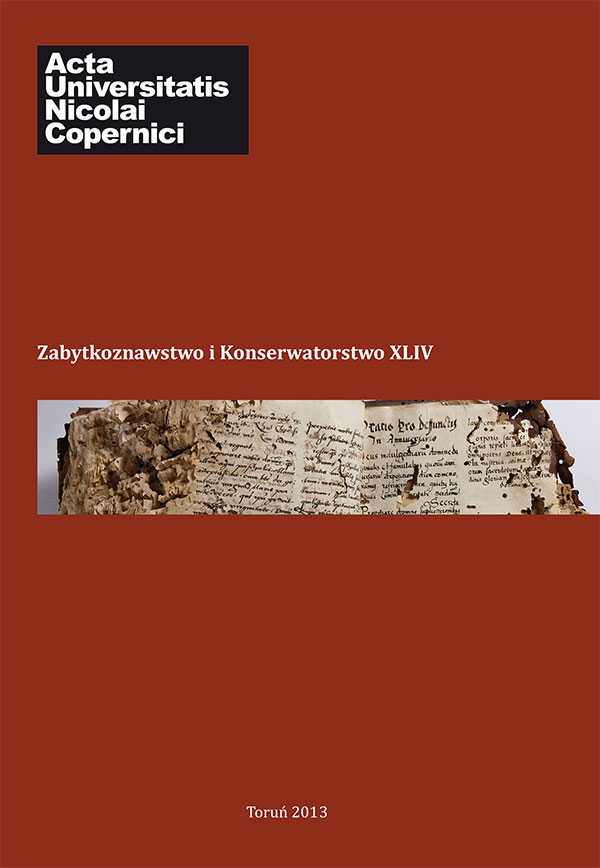Graficzna twórczość Leopolda Lewickiego w Krakowie lat 30. XX wieku i powojennym Lwowie
DOI:
https://doi.org/10.12775/AUNC_ZiK.2013.020Abstrakt
As a painter and graphic artist Lewicki worked in Cracow and Lviv in two extremely different cultural and political conditions, two different ages, separated the chasm of the Second World War. Lewicki’s social involvement as well as his deeply rooted, Communist beliefs influenced his way of perceiving and describing the world, as early as the 1930s, in the language of graphic synthesis. Works created in the 1930s, composed mostly in intaglio techniques (etching, aquatint, drypoint) and few linocuts constitute the illustration of a statement that was formally succinct but possessed immensely rich meaning; they constitute the embodiment of the rule: minimum meanings, maximum means. Intensive artistic activity in the times of the 1st Cracow Group, the themes undertaken in his graphics in the 1930s as well as the activity in the Communist Party of Poland went hand in hand and influenced one another. Lewicki’s graphic output can be divided into two trends: the documentary one that records the examples of everyday life and is involved into socio-political Cracovian themes; and the “structural-geometric” one, mirroring the artist’s interest with the problems of “the mechanization of life”. The works made in intaglio are linear compositions with synthetic and expressive form; in some of them Lewicki contents himself with hasty, as if fragmentary outline and arabesque of lines, in others he diversifies the texture.
The outbreak of the Second World War found him in Chortkiv. After the war, he found his Chortkiv family house burned down, so he settled in Lviv, and became a citizen of the USSR. This choice turned out to be irreversible and marked the rest of his life and, to great extent, his art. In Lvivian times Lewicki created also works on the verge of abstractions, in which groups of geometricized, black, white or filled with various patterns nonfigurative forms were connected with the idea of a figure or an object in the title of this composition. During Cracovian period, apart from “structural” compositions referring to the problems of “mechanization” of a human being, these solutions did not appear at all, and the closest example is the etching Macierzyństwo/ Motherhood from 1932. The abstractions composed at the turn of the 1960s and the 1970s in relief printing technique (woodcut and linocut), Architektura / Architecture, Miasto / City, Miasto w nocy / City at night, and Nowe miasto / New city are “merely” a game of various geometrized forms, contrasted with white and black, sometimes with different colors.
It is curious that after the Second World War Lewicki rarely employed, when it comes to graphic design, metal techniques favoured by him in the 1930s. After the war he used the linocut, before 1945 he made only several works in this technique, and the lithograph he did not employ before. He also made color monotypes in which he copied his previous painting concepts of subordinating the composition into geometricized colourful fields. Apart from “obligatory” drawings that glorified socialist realism the experiments of a mature artist were basically directed into a different direction than in Cracovian times. One can only speculate what would have happened if Lewicki had stayed in Poland after 1945; one can discuss choices he made. Regardless, one should remember that he was incredibly talented Polish-Ukrainian artist of European avant-garde of the twentieth century, in graphic art at times more radical than in painting, and in the opinion of those who knew him, a friendly, modest, open, witty, and engaging man “with great personal charm who left indelible impression on all those who were to meet him”.
Pobrania
Opublikowane
Jak cytować
Numer
Dział
Licencja
CC BY-ND 4.0. Posiadaczem prawa autorskiego (Licencjodawcą) jest Autor, który na mocy umowy licencyjnej udziela nieodpłatnie prawa do eksploatacji dzieła na polach wskazanych w umowie.
- Licencjodawca udziela Licencjobiorcy licencji niewyłącznej na korzystanie z Utworu/przedmiotu prawa pokrewnego w następujących polach eksploatacji: a) utrwalanie Utworu/przedmiotu prawa pokrewnego; b) reprodukowanie (zwielokrotnienie) Utworu/przedmiotu prawa pokrewnego drukiem i techniką cyfrową (e-book, audiobook); c) wprowadzania do obrotu egzemplarzy zwielokrotnionego Utworu/przedmiotu prawa pokrewnego; d) wprowadzenie Utworu/przedmiotu prawa pokrewnego do pamięci komputera; e) rozpowszechnianie utworu w wersji elektronicznej w formule open access na licencji Creative Commons (CC BY-ND 4.0) poprzez platformę cyfrową Wydawnictwa Naukowego UMK oraz repozytorium UMK.
- Korzystanie przez Licencjobiorcę z utrwalonego Utworu ww. polach nie jest ograniczone czasowo ilościowo i terytorialnie.
- Licencjodawca udziela Licencjobiorcy licencji do Utworu/przedmiotu prawa pokrewnego nieodpłatnie na czas nieokreślony
PEŁEN TEKST UMOWY LICENCYJNEJ >>
Statystyki
Liczba wyświetleń i pobrań: 803
Liczba cytowań: 0



